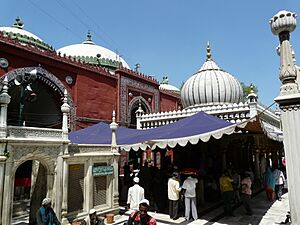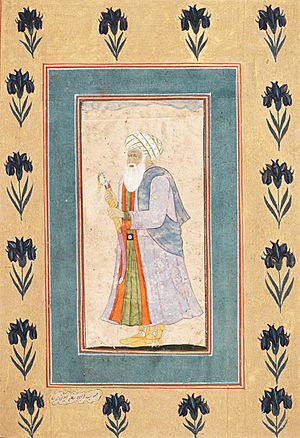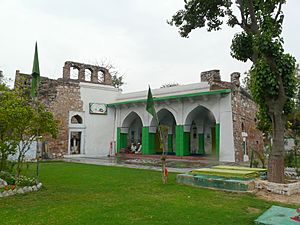Nizamuddin Auliya facts for kids
Quick facts for kids Mohammmad Nizamuddin Awleya |
|
|---|---|
 |
|
| Religion | Islam |
| Denomination | Sunni |
| Order | Chisti order |
| Personal | |
| Born | 1238 AD/ 635 AH Badayun, Delhi Sultanate |
| Died | 3 April 1325 AD/ 18 Rabi Al-Thani 725 AH (aged 86-87) Delhi, Delhi Sultanate |
| Resting place | Nizamuddin Dargah |
| Senior posting | |
| Based in | Delhi |
| Title | Mehboob-E-Ilahi |
| Period in office | Late 13th century and early 14th century |
| Predecessor | Fariduddin Ganjshakar |
| Successor | Various, most prominent being Nasiruddin Chiragh Dehlavi,
Amir Khusrow, Syed Jalaluddin Husain Bukhari alias Makhdoom Jahanian Jahangasht of Uch Sharif, Akhi Siraj Aainae Hind, Burhanuddin Gharib and Syed Najmuddin Ghawsud Dahar Qalandar |
Muhammad Nizamuddin Auliya (1238 – 3 April 1325), also known as Hazrat Nizamuddin, was a famous Sufi saint from India. He was a Muslim scholar and a leader in the Chishti Order, a group focused on spiritual growth and love for God. People often called him Mahbub-e-Ilahi, which means "Beloved of God."
Nizamuddin Auliya followed in the footsteps of great Sufi masters like Fariduddin Ganjshakar, Qutbuddin Bakhtiyar Kaki, and Moinuddin Chishti. These teachers were part of the Chishti spiritual chain in the Indian subcontinent. Like them, Nizamuddin Auliya taught that love is the best way to connect with God. For him, loving God also meant loving all people. He believed in kindness and respecting different religions.
It is said that his teachings greatly influenced the people of Delhi. They became more interested in spiritual life and prayer. He also had disagreements with Ghiyas-ud-din Tughluq, the founder of the Tughluq dynasty, which led to ongoing tensions between them.
Contents
Life Story of Nizamuddin Auliya
Nizamuddin Auliya was born in 1238 in a respected family in Badayun, Uttar Pradesh. When he was five years old, his father passed away. He then moved to Delhi with his mother, Bibi Zulekha. His life story is even mentioned in a famous 16th-century book called Ain-i-Akbari, written by Abu'l-Fazl ibn Mubarak, a minister for the Mughal Emperor Akbar.
At the age of twenty, Nizamuddin traveled to Ajodhan (which is now Pakpattan Sharif in Pakistan). There, he became a student of the Sufi saint Fariduddin Ganjshakar, also known as Baba Farid. Nizamuddin did not stay in Ajodhan. Instead, he continued his religious studies in Delhi. At the same time, he began practicing Sufi prayers and spiritual exercises.
He visited Baba Farid in Ajodhan every year, spending the month of Ramadan with him. During his third visit, Baba Farid chose him as his successor. Soon after, Nizamuddin returned to Delhi and learned that Baba Farid had passed away.
Nizamuddin lived in several places in Delhi before settling in Ghiyaspur. This area was quiet and peaceful, away from the busy city. Here, he built his Khanqah. A Khanqah was a special place where people from all backgrounds could come for food, spiritual lessons, and a place to stay. Soon, his Khanqah became very popular, attracting both rich and poor visitors.
Many of his students became important spiritual leaders themselves. These included Shaikh Nasiruddin Chirag Delhavi and Amir Khusro. Amir Khusro was a famous scholar, singer, and poet for the Delhi Sultanate.
Nizamuddin Auliya passed away on April 3, 1325. His resting place, known as the Nizamuddin Dargah, is in Delhi. The current building was built in 1562. People of all faiths visit this shrine throughout the year. It becomes especially busy during the death anniversaries, called Urs, of Nizamuddin Auliya and Amīr Khusrao, who is also buried there.
Important Beliefs and Teachings
Nizamuddin Auliya believed in the main Sufi ideas. These included finding God in this life by improving oneself and purifying the soul. He taught that this could be done through dedicated Sufi practices. He also added to and practiced special features of the Chishti Sufi order in India.
Some of his key beliefs were:
- Trusting God completely and living a simple life.
- Believing that all people are equal, no matter their social status, wealth, or religion.
- Helping those in need, feeding the hungry, and being kind to people who are struggling.
- He did not like mixing with kings, princes, or nobles.
- He encouraged close contact with the poor and less fortunate.
- He strongly opposed all forms of unfair political and social treatment.
- He allowed Sema, which is a form of spiritual music and chanting.
- However, he believed Sema was only allowed if there were no musical instruments or dancing.
- He held the traditional Sunni belief that musical instruments are not permitted in religious practices.
Nizamuddin did not focus much on the theories of Sufism. He believed that the practical side was more important. He felt it was impossible to fully describe the many spiritual experiences a Sufi might have. He also discouraged showing off special powers, known as Keramat. He taught that saints should hide these abilities from ordinary people. He was also very welcoming to new students. He usually accepted anyone who wanted to become his disciple. Because of this, he was always surrounded by people from all parts of society.
Spiritual Journey

Nizamuddin Auliya was only sixteen or seventeen years old when he first heard about Farīduddīn Ganjshakar. Right away, he felt a deep love and respect for him. He told his students that he never felt the same way about any other Sufi, even after meeting them. This love grew like a burning fire. If his classmates wanted him to do something, they would just mention Baba Farid's name, and he would always agree. He never felt such a strong connection to anyone else in his life. He became Baba Farid's student at age 20, after finishing his studies. He visited Baba Farid three times in his life.
Notable Students
Nizamuddin Auliya had over 600 khalifas. A khalifa is a student given permission to teach others and continue the spiritual lineage. These khalifas helped spread his teachings around the world. Some of his most famous students include:
- Nasiruddin Chiragh Dehlavi: He was Nizamuddin Auliya's spiritual successor. He is considered one of the five most important figures of the Chisti order in India. His shrine is in Chirag Dilli, New Delhi.
- Amir Khusrow: He was Nizamuddin Auliya's most beloved student. They were so close that Nizamuddin Auliya once said he wished they could be buried in the same grave if it were allowed. It is also said that Nizamuddin Auliya asked people to visit Amir Khusrow's grave before his own. Amir Khusrow passed away just a few months after his master. He is buried at the feet of Nizamuddin Auliya in the Nizāmuddīn Dargāh.
- Akhi Siraj Aainae Hind: Nizamuddin Auliya gave him the title Āainae-Hind (Mirror of India). He lived with Nizamuddin Auliya for a long time and was one of his earliest students. He was sent to Bengal to spread the teachings. His shrine is in Pirana Pir Dargah, Malda City, West Bengal.
- Burhanuddin Gharib: He was also one of Nizamuddin Auliya's early students and stayed with him until his death. After Nizamuddin Auliya passed away, he went to the Deccan region, and the place where he lived became famous. His shrine is in Khuldabad in Maharashtra.
The Chisti Nizami Order
Nizamuddin Auliya founded the Chisti Nizami order, a branch of the wider Chishti Sufi order. He had many students who were given permission to spread this order. Many Sufis from the Chisti Nizami order became very well known. This order spread widely across India and beyond.
One important branch, the Nizamia Naseeria branch, was started by his student Nasiruddin Muhammad Chirag-e-Dehli. Another branch, the Hussainia branch, is named after Syed Muhammad Kamaluddin Hussaini Gisudaraz Bandanawaz, who was a famous student of Nasiruddin Muhammad Chirag-e-Dehli. The spiritual center he built in Gulbarga, Karnataka, is still active today.
The Chistia Ashrafia branch was started by Ashraf Jahangir Semnani. He built a spiritual center in Kichaucha Sharif, Uttar Pradesh, which is also still active.
During the Reign of Sultan Mubarak Shah
During the later years of Sultan 'Ala'u'd-Din's rule, there were political problems. Sultan Qutbu'd-Din Mubarak Shah (1316–1320) became ruler. Shaikh Nizamu'd-Din did not get involved in politics. However, Sultan Mubarak Shah became angry with the Shaikh because he had made the Sultan's rival, Khizr Khan, his student.
The Sultan tried to cause trouble for the Shaikh. He told his nobles not to visit Ghiyaspur, where the Shaikh lived. The Sultan also built a mosque and ordered all Sufis and religious scholars to pray there. The Shaikh refused, saying his local mosque was more important to him.
Every month, religious leaders in Delhi would gather at the palace to congratulate the Sultan. The Shaikh further angered the Sultan by sending a servant instead of going himself. The Sultan threatened the Shaikh with serious consequences if he did not come in person. The Shaikh ignored the threat. He quietly prayed at his mother's tomb and returned to his spiritual center. As the last day of the month approached, people in the capital were worried, but the Shaikh remained calm. However, the Sultan did not live to see the first day of the next month. He was killed on July 8, 1320.
Urs Celebrations
The Urs (death anniversary) of Nizamuddin Auliya is celebrated at the Nizamuddin Dargah on the 17th-18th of Rabi II. The Urs of Amir Khusro is celebrated on the 18th of Shawwal.
See also
- Nizamuddin Auliya Dargah
- Mir Sayyid Ali Hamadani
- Ali Hujwiri
- Moinuddin Chishti
- Aaj Rang Hai
- Akhi Siraj Aainae Hind
- Alaul Haq Pandavi
- Ashraf Jahangir Semnani



